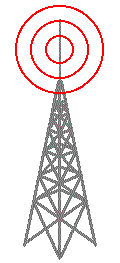
|
N9FH Station tour
My ham radio interests are mostly in contesting and chasing DX
with a little RTTY, Pactor, and CW ragchewing thrown in.
I got my novice ticket around 1977 and held the call WB2WDW through my first 100
or so DXCC countries followed by 15 years of total "radioinactivity" (high
school, college, grad school, and various other distractions). I got the radio bug again a
few years ago and changed calls (KF9ZI). I got my current "vanity"
callsign in May of 1997.
In 1998 we moved out of the city to a spot where I could finally put up a tower!
This page provides an overview of my setup so far. I'm still in the building
phase so check back in a while and see how much I get done. |
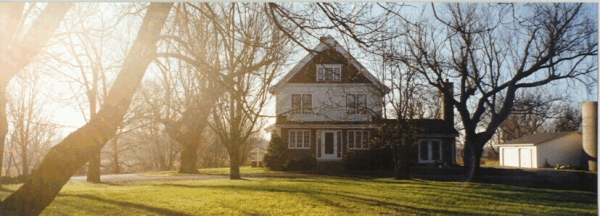
Here's a shot of the new place. We're on top of a small hill and the
terrain slopes away gradually for several thousand feet in all directions. Our lot
is not that large (3.5 acres) but most of the land surrounding us is (as yet) undeveloped. You
can just see part of one of the silos on the right of this photo.
Here are some shots of the
surrounding area from the top of the 82' tower. We have a pretty clear
shot in all directions.
|
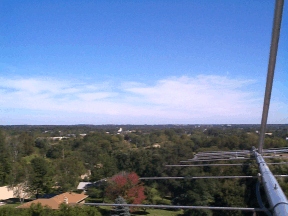
North |
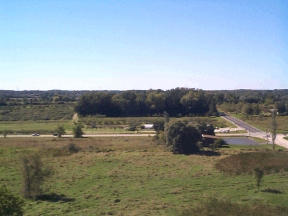
West |
|
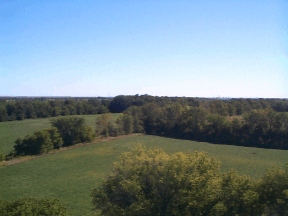
South |
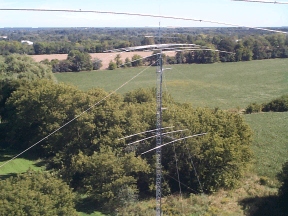
Southeast |
Shack info:
Here is the current shack setup for single op HF
contesting and DXing. We bring other stuff in for VHF and some other
occasional multiop efforts.
You can click on various spots in the image for
more info on each item.
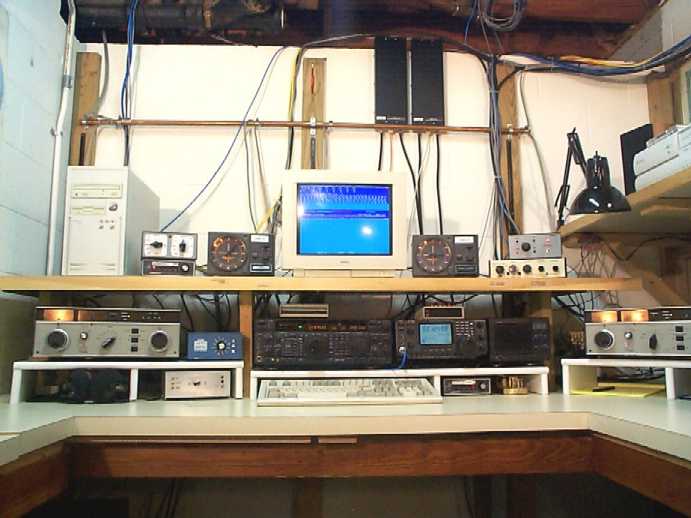
|
P200MHz PC.
|
Manual "8-pack" selector
80m wires
Tower #1 rotator (1000SDX) |
Monitor running TRLog |
Tower #2 rotator (RD-1800)
|
K9AY Loop control
RX preamp / Beverage select
|
|
Ten Tec Titan 425
|
WX0B StackMatch
SO2R controller |
KAM+
FT-1000MP
Keyboard |
Super CMOS III
IC-746
40m wires |
Ten Tec Titan 425
|
|
Each rig now has a Dunestar
bandpass filter to reduce crosstalk between bands.
The audio and keying for the radios are routed through a fairly standard
homebrew SO2R switching setup. All contest logging is done with TR
Log and general logging and DX award tracking is done with DX4WIN.
The main shack computer is a Pentium
200 running Win2K. There also are
several other machines that are networked together for logging during
multiop events. We use W9XT
contest cards in the computers. |
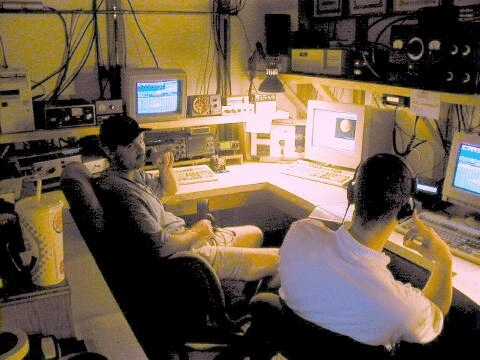 |
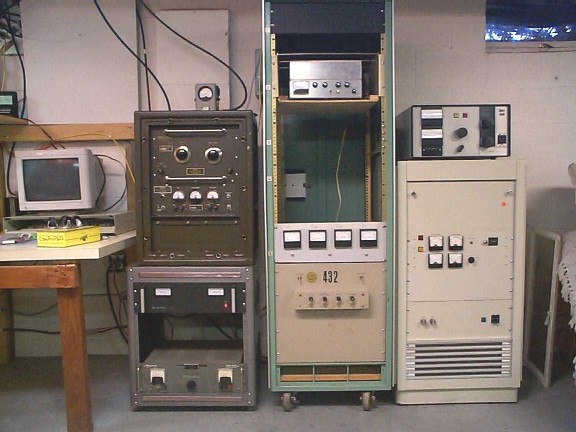 |
Here are a few VHF/UHF
amplifiers. The "Green Machine" on the left is a US
Military surplus AM-494. It runs a pair of 4CX250's on 144MHz. The RF deck
is still pretty much original but I've rebuilt the B+ and screen
supplies.
The center rack has two 423 amps which
both belong to WB9UAI. The top on is a K2RIW style 2 x 4CX250
and the bottom one is a converted Motorola commercial unit.
At right on the bottom is a 220MHz 8877
amp made by Henry Radio. The 2KD Classic on top of it is an HF
amp that I no longer have. |
| Here's a shot of the panel where the feedlines and
control cables come into the shack. There are 16 runs of hardline and several runs of RG-8 coming
in from the yard in addition to a bunch of relay control and rotor
lines.
The silver box on the upper left is the 8x2
antenna selector that allows either of the two radios access to any
antenna. For multiple antennas on a single band there are other
coax switches chained off the 8x2. I'm working on an automatic
controller that will handle 254 possible logical antenna
configurations per radio. Talk about overkill ;-)
|
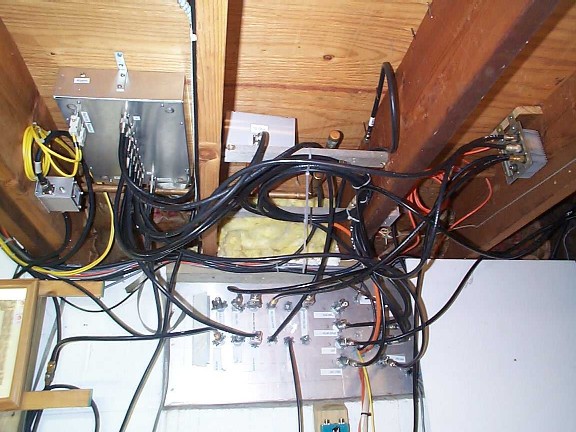
|
Antennas: The
first tower is 70' of Rohn 45 that I put up the summer we moved in. A second tower
(82' of Rohn 45)
is located about 120' to the west of
the first one. Both towers use screw-in guy anchors, 2" OD
1/4" wall DOM steel masts and all guy material is 3/8" fiberglass rod.
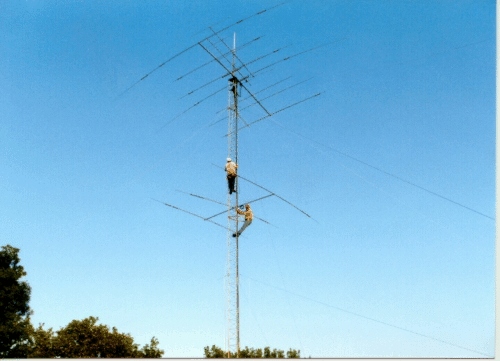
The current setup on tower #1 includes (from top
to bottom):
- 5 EL 50 MHz Yagi,
- 13 EL 144 MHz Yagi
- Mosely Pro-67B 40m-10m
- Cushcraft A3S 3 EL tribander @ 40' fixed E
- KLM 10M4
monobander @25' fixed W
The
Pro-67, A3, and 10m monobander are fed through a StackMatch. Phasing
on the tribanders is pretty close but there's no real performance improvement
due to stacking. The main idea is to be able to point in two directions at
once on 20-10. Running the "mongrel" 4/3/4 stack on 10m sometimes
works great even though the 10m feedline is a random length of 8214.
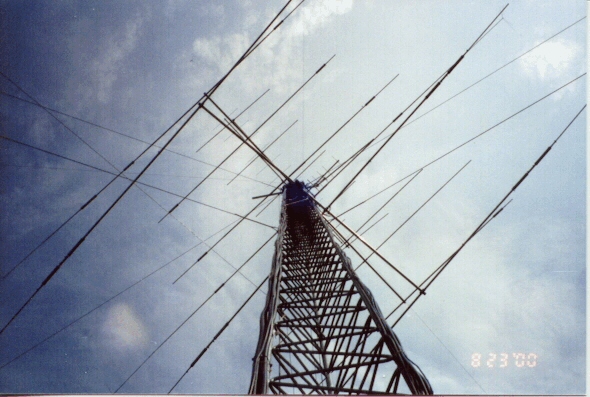 |
In addition to the aluminum, the tower also
supports the following wire antennas:
- 80m 1/4w sloper east
- 80m 1/4w sloper west
- 160m inverted V
- 75m dipole at 50'
The 80m wires have 8-10dB
F/B, are super broad banded (They're cut for CW but work well into the lower end
of 75m), and as a bonus work very well on 30m!
The VHF/UHF stuff
on Tower #1 is fed with 5/8" CATV
hardline. The rest uses RG213 or equivalent.
|
We finished construction of Tower
#2 in August of 2000. It's 82' of Rohn 45 with a 22' steel mast on
top. An RD-1800 turns the following Yagis:
- M-Squared 432-9WL
- KLM 15M4
- Cushcraft 11L 220
- Cushcraft 17B2
- KLM 20M5.
All
runs from the top of the tower to the shack (250') are 3/4" CATV hardline.
The guy system uses 3/8" Polygon guy
rod. The tower also supports a
three-direction 40m dipole array.
| For RX antennas
we have two "shorty"
Beverages that are switched from a common feed point in the southwest corner of
the lot. One wire runs due east and the other runs pretty much
north. They are each about 450' long. The E wire works pretty well
on 80m to Europe. I'm in the process of upgrading this setup to two-wire
versions with better direction switching.
A few years ago I built an array of 4 pennant (rx) antennas
(NE, NW, SE & SW) and switched them
remotely from a common feed point from the shack. Performance was generally
good but the antennas were never more useful than the compromise
Beverages. This year (2003) I switched to a pair of K9AY loops set up just
like the QST article. Results so far with the loops are very
good. |
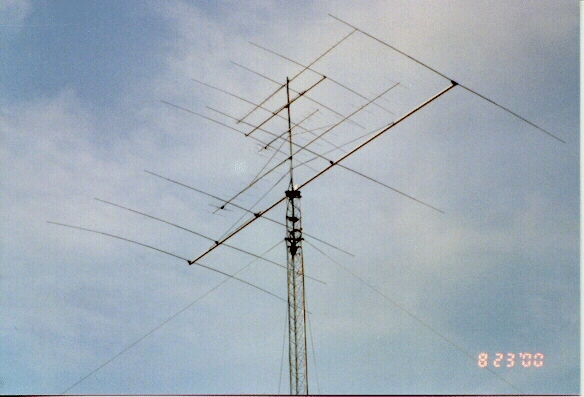 |
Back to
the N9FH homepage












